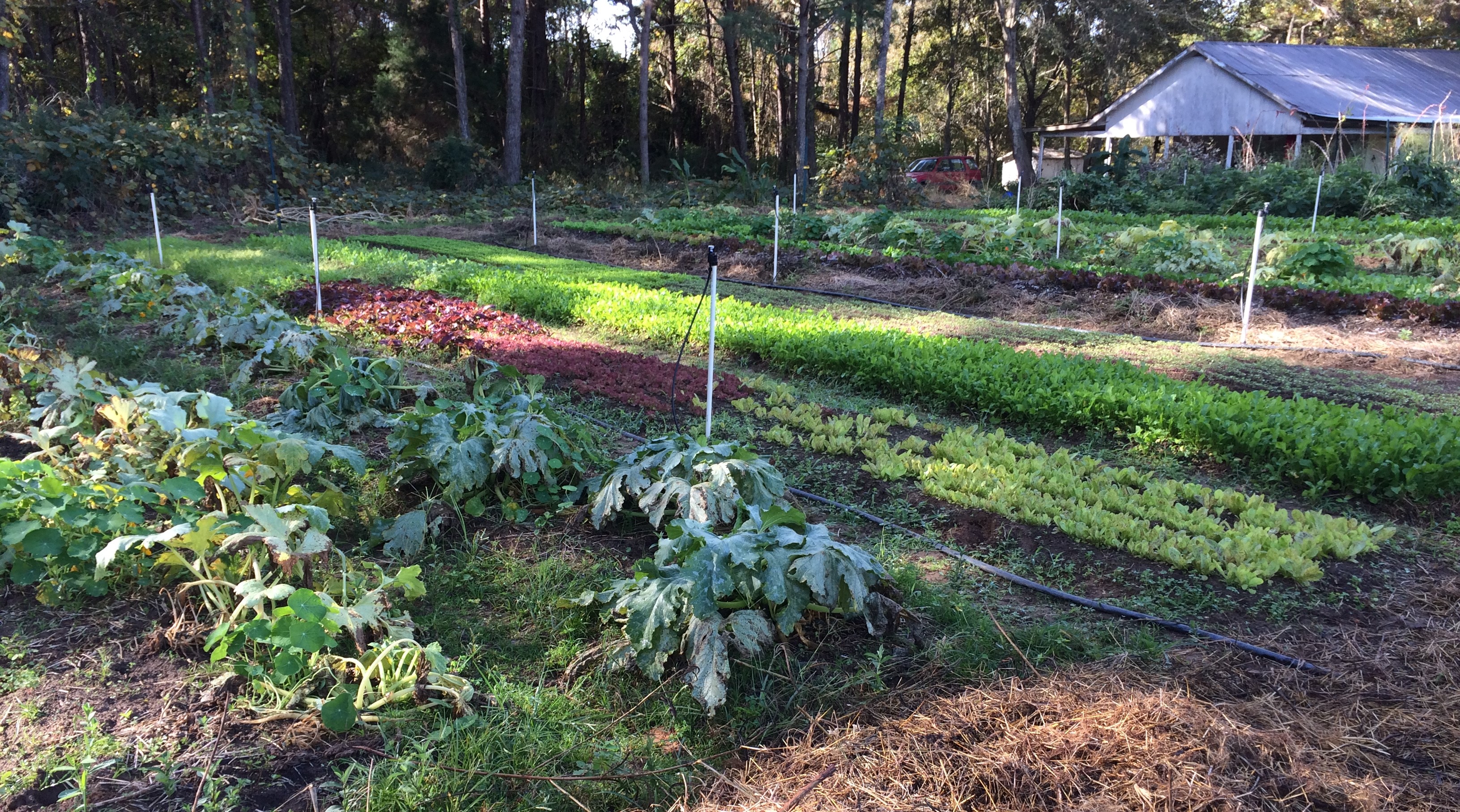
by Molly Jameson | Nov 13, 2017

Take lessons from a farmer to control fire ants in your garden. Photo by Molly Jameson.
As I near the three-year mark of being an Extension Agent, I think about how fortunate I am to have a career that not only encourages me to meet all our local farmers, but also to learn from them and share their knowledge with the community.
A few months ago, I visited Blake Canter of Owen River Farm. Blake gave me the grand tour of his small mixed vegetable plot, which is in far east Tallahassee.
One thing that I remember most about my visit with Blake was what has worked for him in controlling the notorious red imported fire ant (Solenopsis invicta). I have heard of many different ways to control these non-native invaders, each with its drawbacks, and, it seems, anecdotally limited success.
For instance, spinosad, a nervous system toxin, has been known to be effective on fire ant populations and is considered safe to use in vegetable gardens. But in practice, I have heard mixed reviews. In my home garden, I either douse the mounds with boiling water (be careful!) or leave my garden hose in the hot sun and scorch them while the water is still hot. But often, I signal defeat, letting them take captive of two corners of my raised beds.
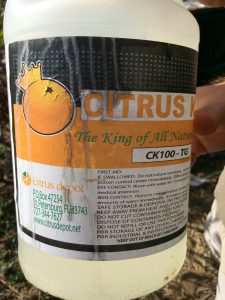
Blake at Owen River Farm makes his fire ant control mixture by combining commercial grade d-Limonene and a hefty squirt of eco-friendly dish soap into five gallons of water. Photo by Molly Jameson.
Blake’s technique on Owen River Farm is using commercial grade d-Limonene, which is a distilled orange oil nerve toxin. Blake mixes one-third cup of d-Limonene with a hefty squirt of eco-friendly dish soap in a five-gallon bucket of water. He then uses this mixture as a drench for fire ant mounds – which he figures is about as effective as boiling water – but much safer and easier to handle (be sure to follow the label carefully when using any product).
Blake goes out early in the morning (when fire ants move slower and queens are usually higher in their nests) and pours the mixture onto the mounds in a spiral formation, from outside in, to minimize escape. He tries to collapse the mound as much as possible, while pouring slowly so it penetrates deeply, with minimal runoff.
Depending on colony size, Blake uses about half the bucket, or more, on just one mound. He warns that he has lost a cucumber plant that was about a foot away to this method, but he knows the ants will often do even more damage, if not sting and bite (they do both!) him hundreds of times, as he works in his vegetable beds.
Blake likes this method because, “I can specifically target the fire ants, and after doing its job, the all-natural orange oil quickly becomes inert. When I used organic ant bait I found that the native ants took up the poison, often times faster than the fire ants. This was particularly bad because native ants are the number one competition for fire ants.”
Blake also points out, “Make sure anyone you recommend this to can identify the difference between fire ant mounds with no center opening to the mound, and native ant mounds, where there is usually an entrance hole in the center of the mound.”
The hardest part, Blake says, is finding the queens. For instance, he says ants often make auxiliary mounds at the base of okra plants, but this is not where the queen resides. The queen will often be in a central mound many yards away from where her workers are foraging. And, unfortunately, these worker ants love easily habitable soft soil, just like in our raised bed vegetable gardens.
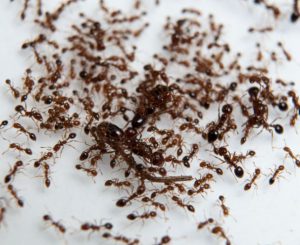
Fire ants in a petri dish. Photo by UF/IFAS.
Despite these challenges, last fall Blake drenched colonies whenever he found a mound around his farm (sometimes daily), and after a few weeks he noticed a drastic reduction in fire ant populations. And happily, an increased population of harmless (and even helpful!) native black ants. His brassica (think kale, collards, broccoli, cabbages) transplants were no longer getting girdled by vicious fire ants and he was no longer ending up with dozens of ant bites every time he worked in his beds!
Blake does warn that you must stay vigilant, especially in the summer and fall and after rain events, when the ants become busy building new colonies.
Lastly, Blake also uses his orange oil mixture as a spray for contact killing ants and other garden pests. However, just as with all horticultural oils and soaps (often made from plant oils, animal fats, or petroleum), care must be taken not to burn the foliage of your crops. Blake will sometimes dilute his mixture for this purpose. But just remember, to really stop an ant infestation, you must take down the queen!
For more information on least-toxic garden pest control strategies, read the UF/IFAS EDIS publication “Natural Products for Managing Landscape and Garden Pests in Florida” available at: https://edis.ifas.ufl.edu/in197.
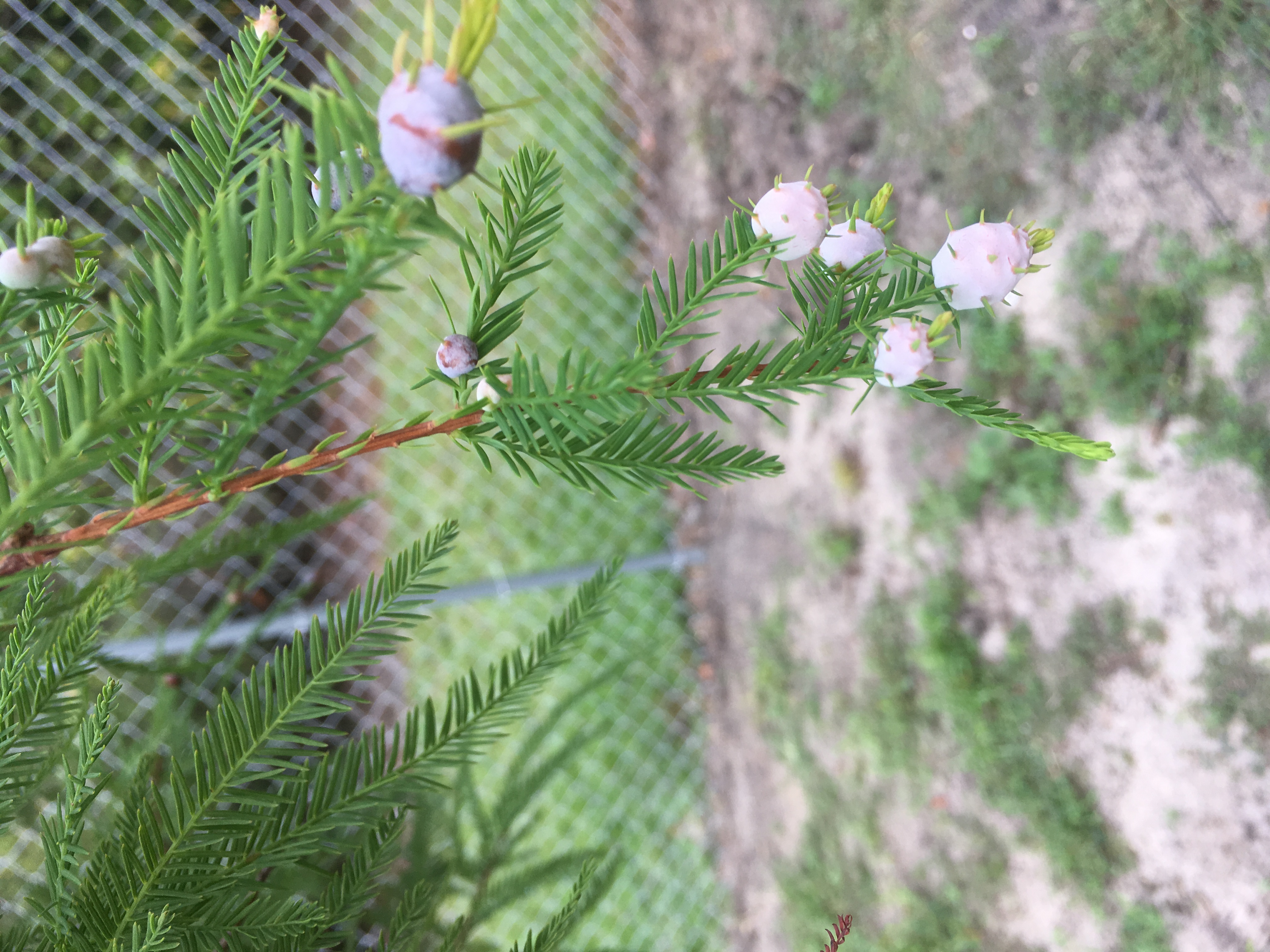
by Julie McConnell | Oct 23, 2017
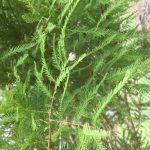
Cypress twig galls on bald cypress leaves. Photo: J_McConnell, UF/IFAS
Bald cypress Taxodium distichum is a native tree that is commonly planted in landscapes because it is adaptable to many sites and grows quickly. It is an interesting tree because it has soft flat leaves that fall off in the winter like other deciduous shade trees; however, it belongs to the Cypress family which consists mostly of needled evergreens.
Like the other cypresses, bald cypress produces cones in the fall, which is a primary means of reproduction for the species in natural settings. During the same season that cones are maturing, you might also see what looks like cones forming at the tips of branches among the leaflets rather than along the stem. These mysterious growths are not cones but rather twig galls.
Bald cypress twig galls are abnormal growths of leaf bud tissue triggered by the attack of the cypress twig gall midge Taxodiomyia cupressiananassa. In late spring, adult midges lay eggs on new leaves of the bald cypress. As the eggs hatch and midge larvae start feeding on the bald cypress leaves the growth of a twig gall is induced. The larvae take advantage of this gall using it for food and shelter throughout the larval stage and into the pupal stage. After pupation, adults emerge from the galls, mate, and females lay an average of 120 eggs over a two-day lifespan as an adult. This first generation lays eggs on mature leaves which starts the cycle again. The galls formed by the second generation of the year fall off and overwinter on the ground.
The galls do not appear to affect the health of trees overall, although the weight of heavily infested branches may cause drooping. There are many natural enemies of the twig cypress gall midge, so applying insecticides are not recommended since they may cause harm to non-target insects. The simplest management option is to collect and destroy the galls in the spring and fall to reduce populations the following season.
To read more about bald cypress trees or the twig gall please see the following publications:
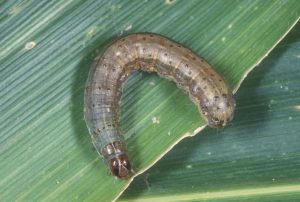
by Sheila Dunning | Aug 17, 2017
If you are one of the many that have taken advantage of the frequent rain in order to establish a new lawn, keep an eye open for “grass worms”. Though truly caterpillars, not worms, these destructive, chewing insects can wreak havoc on new sod.

Sod Webworm Photo by: Lyle Buss UF
Tropical sod webworm larvae are destructive pests of warm season turfgrasses in the southeastern U.S. especially on newly established sod. Larval feeding damage reduces turfgrass aesthetics, vigor, photosynthesis and density, which is very evident on finer-bladed grasses such as bermudagrass and zoysiagrass. Adults, a dull brown colored moth about ¾ inch long, rest in sheltered and shrubby areas during the day and are active at dusk. Females deposit clusters of 10-35 eggs on the upper surface of grass blades. The eggs hatch in 3-4 days and develop from a 1 mm long caterpillar to one over 11 mm long through six instars within 21 to 47 days, depending on temperature. Larval feeding occurs at night, leaving the grass looking ragged, shortened and missing.
Control should be against damaging larvae, not the flying moths. However, insecticidal soap applications to moth harboring areas can reduce re-population frequency if such areas are located. Soil-drenching soap flushes can be used to find the caterpillars, especially in dry and hot grass areas. Bacterial-based insecticides will control sod webworm caterpillars without impacting beneficial species as long as they are applied with each flush of grass growth.
Excessive fertilizing will lead to caterpillar outbreaks in lawns. Newly installed sod is usually rich in nutrients and rapid growing, which makes it very attractive to sod webworms. Grass installation over the summer months should be immediately followed by sod webworm treatment.

Fall Armyworm Photo by: Lyle Buss UF
Fall armyworms are also attracted to newly installed sod. They feed any time of the day or night, but are most active early in the morning or late in the evening. The 1 ½ inch long gray and white moth lays about 1,000 eggs in multiple masses on any vegetation. Two to 10 days later, the small caterpillar hatches and begins to grow to nearly 2 inches long over a two week period. The fall armyworm is easily recognized by its dark head marked with a distinct pale-colored inverted Y and the long black stripe running along each side of its body. These aggressive feeders “march” rapidly across grassed areas consuming every above-ground plant part. While bacterial-based insecticides will reduce the numbers, control of armyworms usually requires synthetic insecticides. Diligent inspection and early pesticide application is critical to establishment of new sod installed during the summer months.
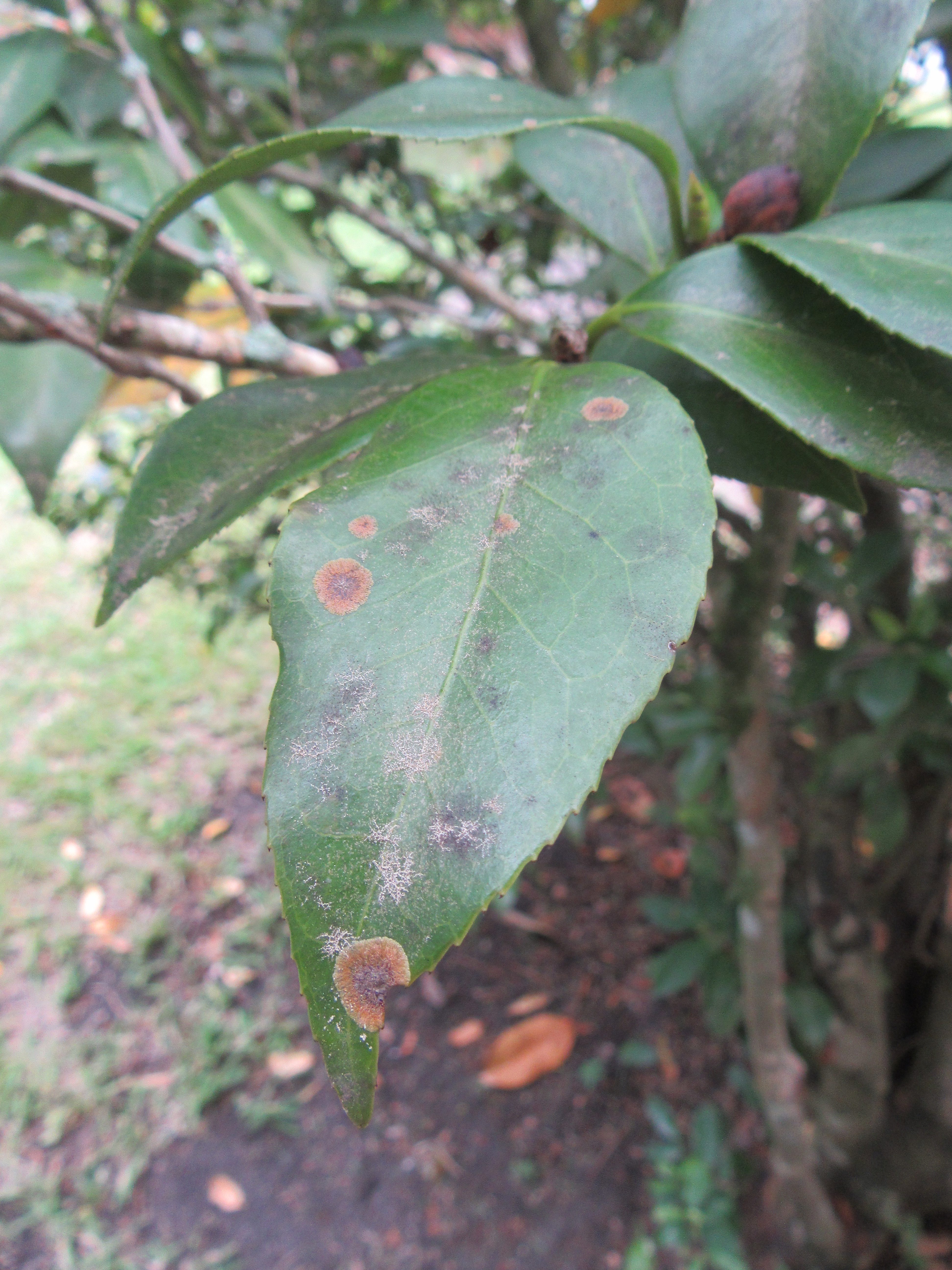
by Matt Lollar | Jun 29, 2017
Algal leaf spot, also known as green scurf, is commonly found on thick-leaved, evergreen trees and shrubs such as magnolias and camellias. It is in the genus Cephaleuros and happens to be one of the only plant parasitic algae found in the United States. Although commonly found on magnolias and camellias, algal leaf spot has a host range of more than 200 species including Indian hawthorn, holly, and even guava in tropical climates. Algal leaf spot thrives in hot and humid conditions, so it can be found in the Florida Panhandle nearly year round and will be very prevalent after all the rain we’ve had lately.
Symptoms
Algal leaf spot is usually found on plant leaves, but it can also affect stems, branches, and fruit. The leaf spots are generally circular in shape with wavy or feathered edges and are raised from the leaf surface. The color of the spots ranges from light green to gray to brown. In the summer, the spots will become more pronounced and reddish, spore-producing structures will develop. In severe cases, leaves will yellow and drop from the plant.
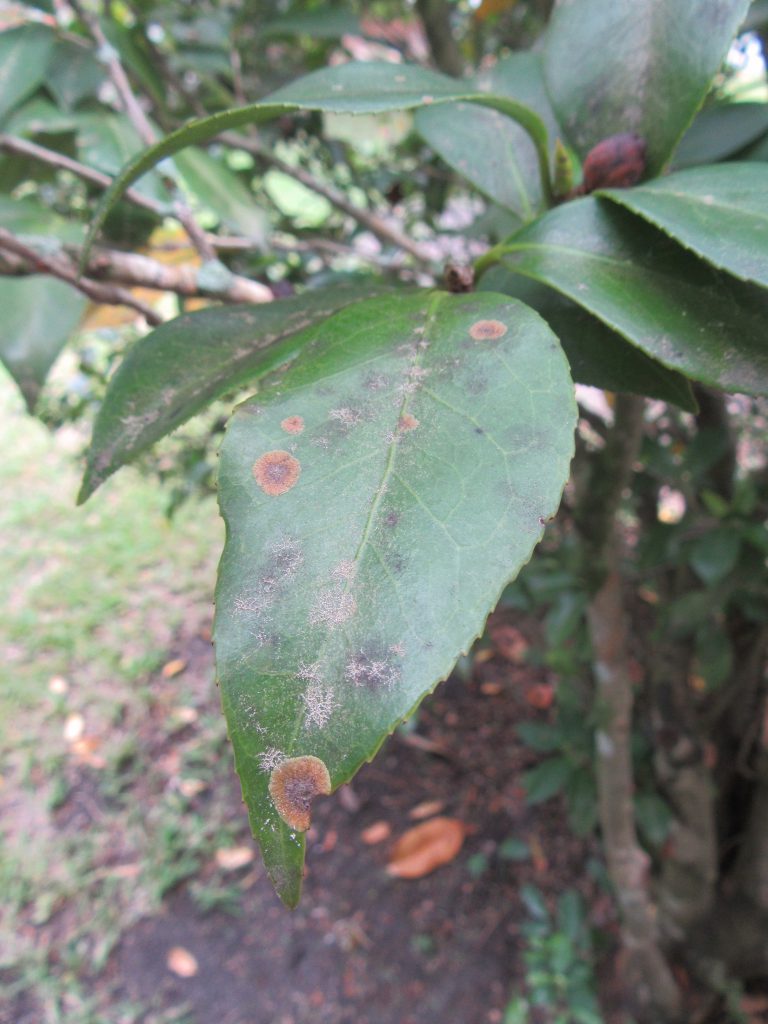
Algal leaf spot on a camellia leaf. Photo Credit: University of Florida/IFAS Extension
The algae can move to the stems and branches in more extreme cases. The algae can infect the stems and branches by entering through a small crack or crevice in the bark. The bark in that area cracks as a canker forms that eventually can girdle the branch, killing it.
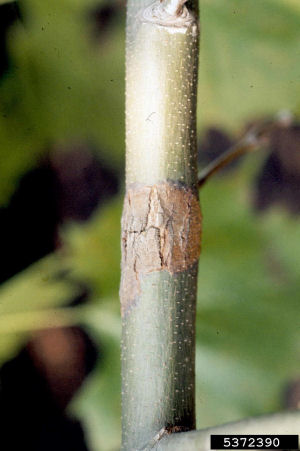
Algal leaf spot on a sycamore branch. (Platanus occidentalis). Photo Credit: Florida Division of Plant Industry Archive, Bugwood.org.
Management
In most cases, algal leaf spot is only an aesthetic issue. If only a few leaves are affected, then they can just be removed by hand. \It is important that symptomatic leaves are discarded or composted offsite instead of being left in the mulched area around the trees or shrubs. If symptomatic leaves are left in the same general area then irrigation or rain water can splash the algal spores on healthy leaves and branches. Infected branches can also be removed and pruned.
Preventative measures are recommended for long-term management of algal leaf spot. Growing conditions can be improved by making sure that plants receive the recommended amount of sunlight, water, and fertilizer. Additionally, air circulation around affected plants can be increased by selectively pruning some branches and removing or thinning out nearby shrubs and trees. It is also important to avoid overhead irrigation whenever possible.
Fungicide application may be necessary in severe cases. Copper fungicides such as Southern Ag Liquid Copper Fungicide, Monterey Liqui-Cop Fungicide Concentrate, and Bonide Liquid Copper Fungicide are recommended. Copper may need to be sprayed every 2 weeks if wet conditions persist.
Algal leaf spot isn’t a major pathogen of shrubs and trees, but it can cause significant damage if left untreated. The first step to management is accurate identification of the problem. If you have any uncertainty, feel free to contact your local Extension Office and ask for the Master Gardener Help Desk or your County Horticulture Agent.
by Sheila Dunning | May 25, 2017
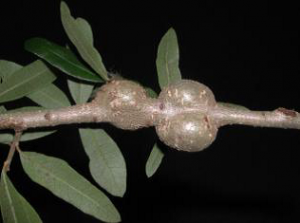 As oak trees are now fully leafing out and people start hanging out in the shade of the canopy, many of you are noticing strange growths on the branches. They look like potatoes, spiky cones and fuzz balls on the leaves and stems. Don’t worry. It’s just a harmless wasp that chose that tree to create a nursery for her young.
As oak trees are now fully leafing out and people start hanging out in the shade of the canopy, many of you are noticing strange growths on the branches. They look like potatoes, spiky cones and fuzz balls on the leaves and stems. Don’t worry. It’s just a harmless wasp that chose that tree to create a nursery for her young.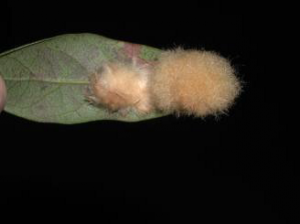
Galls are abnormal plant growth or swellings comprised of plant tissue. Galls are usually found on foliage or twigs. These unusual deformities are caused by plant growth-regulating chemicals produced by tiny wasps. The chemicals produced by these insects interfere with normal plant cell growth.
The life cycles of the various gall-forming wasps are highly variable. Two or more years are required for gall wasps that develop in woody twig galls to reach maturity. Gall-forming wasps usually overwinter as adults in protected places away from the host tree. As the buds break in the spring and the leaves begin to expand, these small wasps start to lay their eggs in expanding plant tissue. During the egg-laying process or early larval-feeding period, specialized body glands secrete growth-regulating chemicals that interact with certain plant chemicals to produce these abnormal growths.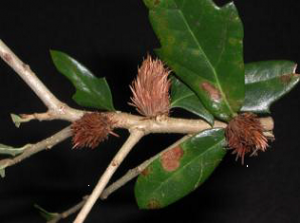
After a brief period of cell growth, gall development stops completely. Once these galls are formed, they do not continue to use nutrients from the host plant. The insect is confined within “its house” and feeds only on gall tissue during the remainder of its development. The galls provide shelter, protection, and food for the immature wasps. Inside a gall, the larvae are surrounded by tissues rich in nutrients
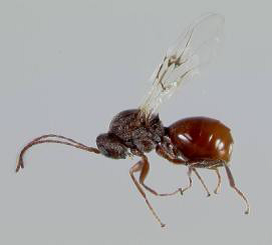 There are a variety of gall-forming species of small wasps that commonly infest oak, Quercus spp ., trees. Galls generally are aesthetically objectionable to homeowners who find them unattractive and fear that galls will cause damage to the health of their oak trees. Most leaf galls on oak cause little or no harm to the health of a tree. However, twig or branch galls may cause injury by distorting branch development in a heavily infested tree.
There are a variety of gall-forming species of small wasps that commonly infest oak, Quercus spp ., trees. Galls generally are aesthetically objectionable to homeowners who find them unattractive and fear that galls will cause damage to the health of their oak trees. Most leaf galls on oak cause little or no harm to the health of a tree. However, twig or branch galls may cause injury by distorting branch development in a heavily infested tree.
Chemical control is seldom suggested for management of leaf galls on oak. Cultural methods of control may be effective in reducing the impact of these insects. Some fallen leaves may harbor various life stages of gall-producing pests. Therefore, it may be useful to collect and destroy all infested leaves. Some of these pests overwinter in twigs and branches of oak. Where such woody galls are detected, prune and destroy the infested plant material when the galls are small and have just started to develop. But, remember every bug needs a home!
All photos by Eileen Buss, UF Entomologist
by Matt Lollar | May 18, 2017
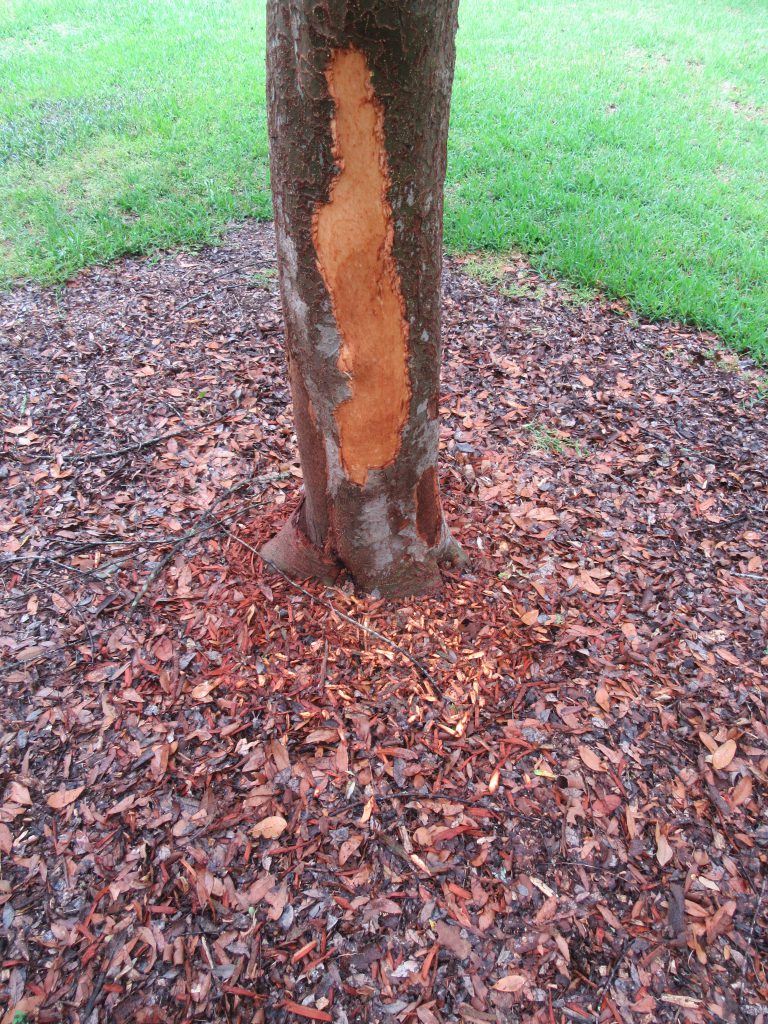
Squirrel bark stripping damage on a Chinese elm. Photo Credit: University of Florida/IFAS Extension
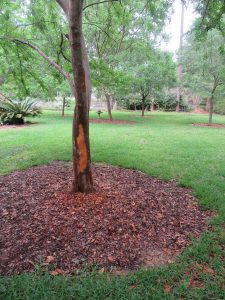
Barked stripped from the trunk of a Chinese elm. Photo Credit: University of Florida/IFAS Extension
The squirrels are at it again! This time they are stripping the bark from the trunks of my Chinese elm (Ulmus parvifolia) trees. Squirrels feed on the bark of a number of other different tree species including oaks, maples, and pecans. There are a few theories as to why squirrels feed on tree bark.
- Pregnant Females – Pregnant squirrels don’t eat prior to giving birth, but it is thought they chew on bark to help them bear the pain of pregnancy.
- Water Source – This theory isn’t very reputable due to the fact that squirrels have been seen feeding on bark come rain or shine.
- Food Source – The inner bark layer (phloem) contains sugar and nutrients which help satisfy a squirrel’s appetite.
The good news is squirrels generally do not eat enough bark to kill a tree. A squirrel will typically only strip a half inch section of bark about three inches long. However, the squirrels in my yard were much hungrier this year as you can see in the featured pictures.
Because squirrels do not usually girdle the trunk of the tree, they generally do not cause enough damage to kill a tree. However, their bark stripping habits can be unsightly in a well-maintained landscape. A few control options are available.
- Tree Wrap – Tree trunks can be wrapped with 24″ or longer aluminum flashing. Unfortunately, this option can be more unsightly than the bark stripped trunks.
- Repellents – A number of different wildlife repellents are on the market. Most repellents do not smell very good because they contain egg solids.
- Harvest – This is my favorite method of control! Make sure you follow all state and local laws.
For more information on wildlife management, please visit EDIS or The Internet Center for Wildlife Damage Management.

















